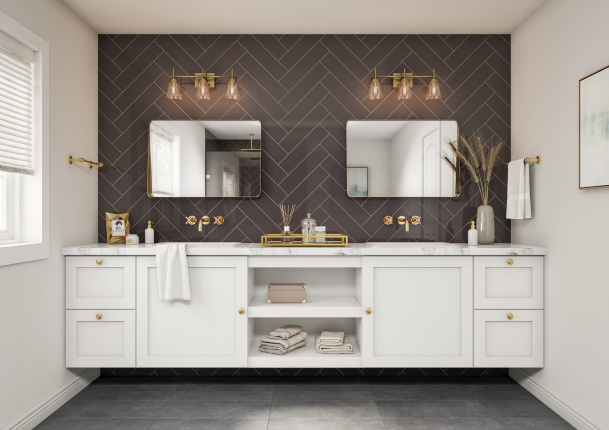Tile Installation in Doral
Are you considering a tile installation project for your home or commercial space? If so, porcelain tiles might be just what you need to achieve a durable, elegant, and long-lasting finish. At D&B Tile, we're passionate about helping you make informed choices for your projects. That’s why we provide the best products and walk you through tile installation in Doral.

Most Common Types of Tiles Used for Installation
When it comes to tile installation, you have several options to choose from, such as:
Ceramic Tiles
Ceramic tiles are a popular choice for various applications, from kitchen backsplashes to bathroom floors. They are made from clay fired at high temperatures, which makes them sturdy and resistant to wear and tear.
Ceramic tiles are available in a wide range of colors, sizes, and patterns, making them suitable for almost any design style.
Porcelain Tiles
Porcelain tiles, a subset of ceramic tiles, are known for their exceptional durability and resistance to moisture. They are made from a finer clay that is fired at temperatures of up to 1400 degrees Celsius. As a result, they become a dense and hard-wearing surface.
Porcelain tiles are perfect for high-traffic areas like kitchens, bathrooms, and outdoor spaces, as they don’t absorb water or stains and are easy to maintain.
Natural Stone Tiles
Natural stone tiles, such as marble, granite, travertine, and slate, offer a luxurious and timeless look. They are ideal for adding an elegant touch to your spaces. However, natural stone tiles require regular maintenance and sealing to preserve their beauty and prevent staining.
Glass Tiles
Glass tiles add a touch of modernity and sophistication to any space. They are commonly used for backsplashes and accent walls, creating a glossy, reflective surface that enhances the overall aesthetic. Glass tiles come in various sizes, colors, and finishes to suit your design preferences.
Mosaic Tiles
Mosaic tiles consist of small pieces of glass, ceramic, or natural stone arranged in intricate patterns. They are excellent for creating eye-catching designs, whether as a feature wall or a decorative accent. Mosaic tiles are versatile and can be used in both wet and dry areas.

How Do I Calculate the Amount of Tile Needed for My Project?
Before you start your tile installation project, you must determine how much tile you'll need to cover the area. Here's a simple method to calculate it:
- Measure the Area: Measure the length and width of the surface you want to tile in square feet. For irregularly shaped areas, divide them into smaller, more manageable sections.
- Account for Wastage: We recommend you add about 10% to your total square footage to account for cuts, breakage, and future repairs.
The Process of Tile Installation
Now that you've chosen porcelain tiles and calculated the amount you need, let's dive into the process of tile installation. Proper installation ensures the longevity and beauty of your new tile surface.
Here's a step-by-step guide:
- Surface Preparation
- Clean and Smooth Surface: Ensure the surface is clean, free of debris, and smooth. Repair cracks or imperfections in the substrate.
- Layout Planning: Plan the layout of your tiles, starting from the center of the room. This process helps achieve symmetrical patterns and minimizes tile cutting.
- Adhesive Application
- Select the Right Adhesive: Choose a high-quality thin-set mortar suitable for porcelain tiles and your specific substrate.
- Spread the Mortar: Use a notched trowel to spread the mortar evenly over a small section of the substrate.
- Tile Installation
- Place the Tiles: Carefully press each tile into the mortar, using spacers to maintain consistent gaps between them.
- Check for Level: Use a level to ensure that the tiles are even and level with one another.
- Cut Tiles as Needed: For tiles that need to fit around edges or corners, use a tile cutter or wet saw to make precise cuts.
- Grout Application
- Mix the Grout: Follow the manufacturer's instructions to mix the grout to the right consistency.
- Apply the Grout: Use a rubber float to press the grout into the gaps between the tiles at a 45-degree angle.
- Clean Excess Grout: After about 15-20 minutes, wipe off excess grout from the tiles using a damp sponge.
- Curing and Sealing
- Curing Time: Allow the grout to cure for the recommended time before walking on or using the tiled surface.
- Seal the Grout: Applying a grout sealer helps protect against staining and moisture penetration. Follow the manufacturer's guidelines for sealing frequency.
Want to Learn More About Tile Installation in Doral?
With generations of experience and strong partnerships with top suppliers, we have the expertise to transform your home or commercial space. Our tile experts are here to assist you every step of the way, from selecting the perfect porcelain tiles to providing guidance on installation.
Transform your space with D&B Tile and experience the difference quality tiles can make. Contact us today!

